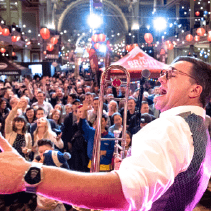Publicity is something that every event wants, but many feel is out of reach. According to our 2020 Event Trends Report, only 44% of event creators are using PR to attract attendees to their events.
With social media at everyone’s fingertips, it can be tempting to rely on your own channels to spread the word. But the right media coverage can help project your event to a whole new audience. Of course, not every event is going to land major press coverage in newspapers and radio, but that doesn’t mean smaller or more niche events can’t achieve publicity.
The best way to kickstart a PR campaign and build a reputation for a smaller or more niche event is to negotiate media partnerships. Look outside of traditional mainstream media for opportunities. Think industry publications and blogs, community or brand newsletters, podcasts, city guides and top 10 lists, tourism websites – the list is endless. Here are three steps to get you started on establishing media partnerships for your next event.
Step 1: Know who you’re targeting
Take a considered approach to media partnerships by finding the right networks to target. Establish who your target audience is for your event and use this to research and identify online networks with large databases that will help you to market your event directly to your ideal consumer. Let’s look at an example:
Imagine you are organising a training seminar for people that work in the recruitment industry. Start by doing some research and find websites that have a large database of recruitment professionals such as online membership bodies, societies or even online recruitment magazines. Next, check that company’s social status to find out how many followers and employees they have.
Step 2: Find the right partners
If you find a potential partner that looks promising, use LinkedIn to find out who is in charge of marketing and send them a short email and proposal. Think of these partnerships like a sponsorship agreement, where you offer a win-win arrangement that can promote you event while being of benefit to their business. For example, you could offer them a media sponsorship with logos and mentions in your event collateral, in exchange for a mention in their newsletter and social media channels. Or you could offer an exclusive discount code to their members as an incentive for promoting your event.
Some companies will say no, but don’t take it personally. Be persistent, move on and you will find a company willing to work with you. This is why research is important. Aim to find 10-20 websites with a large or highly targeted database of your audience. You can use Eventbrite to create a unique discount codes or tracking links exclusively for your media partner’s database, which allows you to track the strength and success of each campaign.
Step 3: Get your messaging right
Rather than blasting out your ‘buy tickets’ message to every media partner, work with your partners to create copy or editorial that appeals to their readership. If you can write interesting and compelling content about your event or subject expertise, your partner is more likely to publish it. Download The Ultimate Guide to Copywriting for Events for the lowdown on how to write about your event.
Unlock ‘The Mastery of PR’
For more with establishing media relationships and crafting press releases, check out this three-part series on ‘The Mastery of PR’:
- 5 Steps to Make Your Event Press-Worthy
- How to Craft a Riveting Press Release
- Beyond The Press Release
To learn more about overlooked promotional tactics to drive attendees for your event, download The 2020 Event Trends Report.






